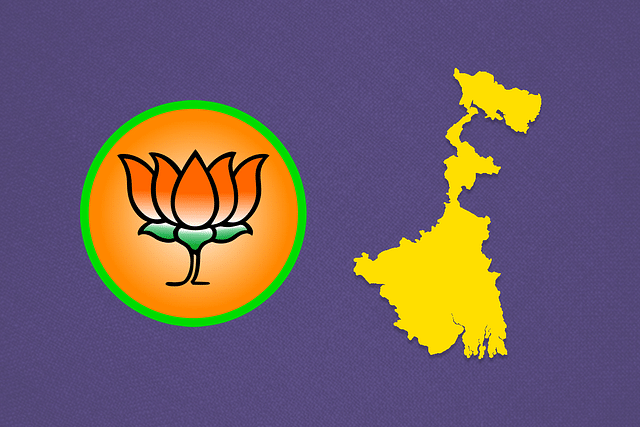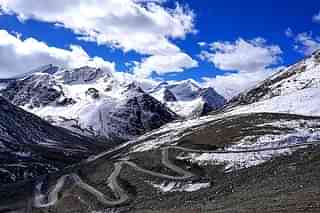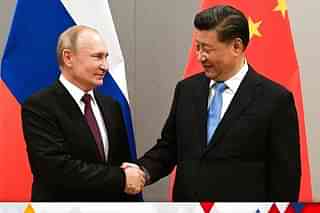Politics
In Maps: BJP Looks Set To Become Largest Party In Bengal
Venu Gopal Narayanan
May 06, 2024, 01:37 PM | Updated 01:37 PM IST
Save & read from anywhere!
Bookmark stories for easy access on any device or the Swarajya app.

With 42 Lok Sabha seats, West Bengal is a prized province in every general election. Once a Congress preserve in the decades following Independence, it transformed into a communist bastion until earlier this century, when the reins shifted comprehensively to the Trinamool Congress (TMC).
But now, after long decades of arduous toil, it appears that the Bharatiya Janata Party (BJP) stands on the cusp of becoming the largest political force in the state at last.
In the past three general elections, its vote share has risen from a paltry 6 per cent to a formidable 40 per cent, with the bulk of its gains coming from the Left parties.


As incongruous as it may seem for a land which gave birth to Swami Vivekananda, Rabindranath Tagore and Shyama Prasad Mukherjee, these electoral verdicts have been a sordid function of successful identity politics; the demographics of West Bengal have made it susceptible to vote banking via multiple social coalitions.
Around a third of the population is Muslim, a quarter are Dalits, and tribals constitute five per cent, with all three groups concentrated more heavily in large pockets.
As a map below shows, Muslims are sparser in the southwest of the state, and collected more densely along The Hooghly. This distribution constitutes a principal catchment area for the TMC.


Tribals, though numerically small at the state level, are concentrated in the southwest and the north. Two seats of a total 42 are reserved for Scheduled Tribes (ST).
From 1977 to 2009, both seats were consistently won by the Left. But in 2014, both went to the TMC; and in 2019, in a shift which should have been analysed more astutely at the time, both reserved ST seats were won by the BJP.


The distribution of the Dalit population largely mirrors that of Muslims.
Historically, the two groups constituted a redoubtable Muslim-Dalit axis which supported the Left parties. That is why the Left won all reserved Scheduled Caste (SC) seats in the state from 1977 to 2009.
This is probably a record without parallel. In 2014, as a result of a vote shift from the Left to the TMC, this axis gifted all 10 SC reserved seats to the TMC.
It is this TMC Muslim-Dalit axis which the BJP first dented in 2019, when its vote share went up to 40 per cent and it won 18 of 42 seats in West Bengal.
That year, the BJP won five of 10 SC seats — two in the far north, and three in a belt upstream of Kolkata.


As a result of these vote shifts between 2009 and today, the TMC’s core areas have largely shrunk to a densely-populated zone stretching south from central Bengal to the Sundarbans.
Curiously, these changing electoral outcomes mirror demographics fairly well. That is best depicted by two comparative maps: one, the election results of the 2019 general elections, and another, the combined Muslim-plus-Dalit census map by district.


Readers may note how well the BJP performed in the southwest and the north, and how (or why) the TMC retained its strongholds in central Bengal and the delta region.
The inference is that, while the BJP has managed to breach the TMC’s Muslim-Dalit axis, the fissure has yet to be forced apart in fuller measure.
These maps are also pointers towards the manner in which the state government has handled the shocking incidents which recently came to light at Sandeshkhali (location plotted as red dot on 2019 wins map above left).
It is as if there is one political force which is somehow, desperately, trying to keep its vote banks intact, and one, which is seeking to institute a supra-caste consolidation.
In this backdrop, what augurs for West Bengal in the 2024 general elections? A good indicator is a 2019 win-loss vote margin for the BJP, again plotted beside a combined Muslim-plus-Dalit demographics map.


Note the reds in the map above. These are the seats where the TMC defeated the BJP by the heftiest margins, and these are the seats which the BJP is actively gunning for in 2024.
According to multiple opinion polls, it appears that the BJP is poised to increase its vote share and win at least as many seats as the TMC, if not more. This is possible, since the index of opposition unity in West Bengal has reduced to near zero.
On paper, the Left, the TMC, and the Congress, are all ostensibly members of the same I.N.D.I. Alliance, but the situation is very different on the ground.
There is no seat sharing; the TMC is contesting all 42 seats plus high anti-incumbency.
The Left is hoping for some sort of a resurgence, even if its vote share is down to single digits, and even if it failed to come second in a single seat in 2019.
The Congress, which hopes to retain its two remaining strongholds in central Bengal, has been raining enfilade fire on the TMC this past week. If this is an alliance, then one shudders to think what a falling out might look like.
Consequently, and in conclusion, there is a good probability that the BJP will force the breach it made in 2019, and register its best performance in the state to date.
Save & read from anywhere!
Bookmark stories for easy access on any device or the Swarajya app.
Venu Gopal Narayanan is an independent upstream petroleum consultant who focuses on energy, geopolitics, current affairs and electoral arithmetic. He tweets at @ideorogue.
Support Swarajya's 50 Ground Reports Project & Sponsor A Story
Every general election Swarajya does a 50 ground reports project.
Aimed only at serious readers and those who appreciate the nuances of political undercurrents, the project provides a sense of India's electoral landscape. As you know, these reports are produced after considerable investment of travel, time and effort on the ground.
This time too we've kicked off the project in style and have covered over 30 constituencies already. If you're someone who appreciates such work and have enjoyed our coverage please consider sponsoring a ground report for just Rs 2999 to Rs 19,999 - it goes a long way in helping us produce more quality reportage.
You can also back this project by becoming a subscriber for as little as Rs 999 - so do click on this links and choose a plan that suits you and back us.
Click below to contribute.





